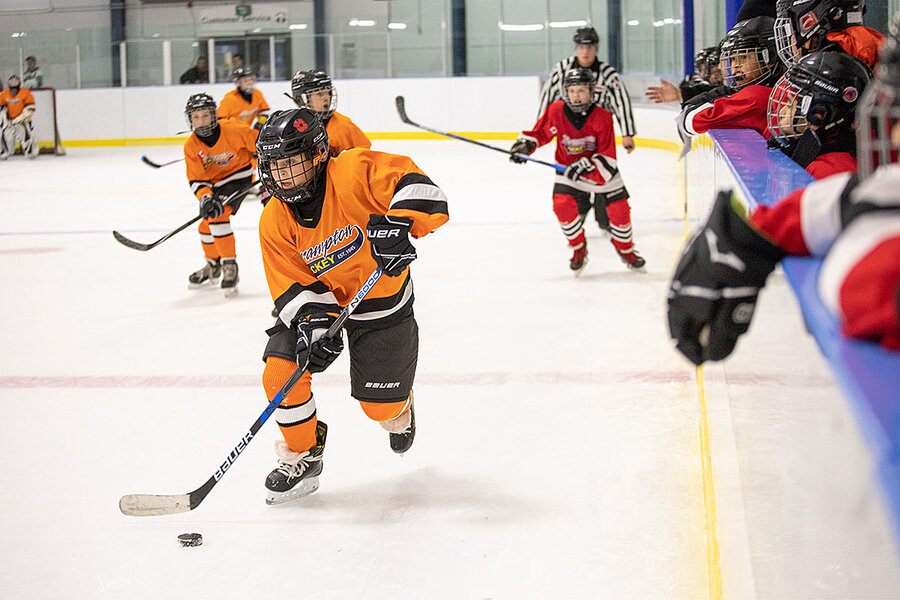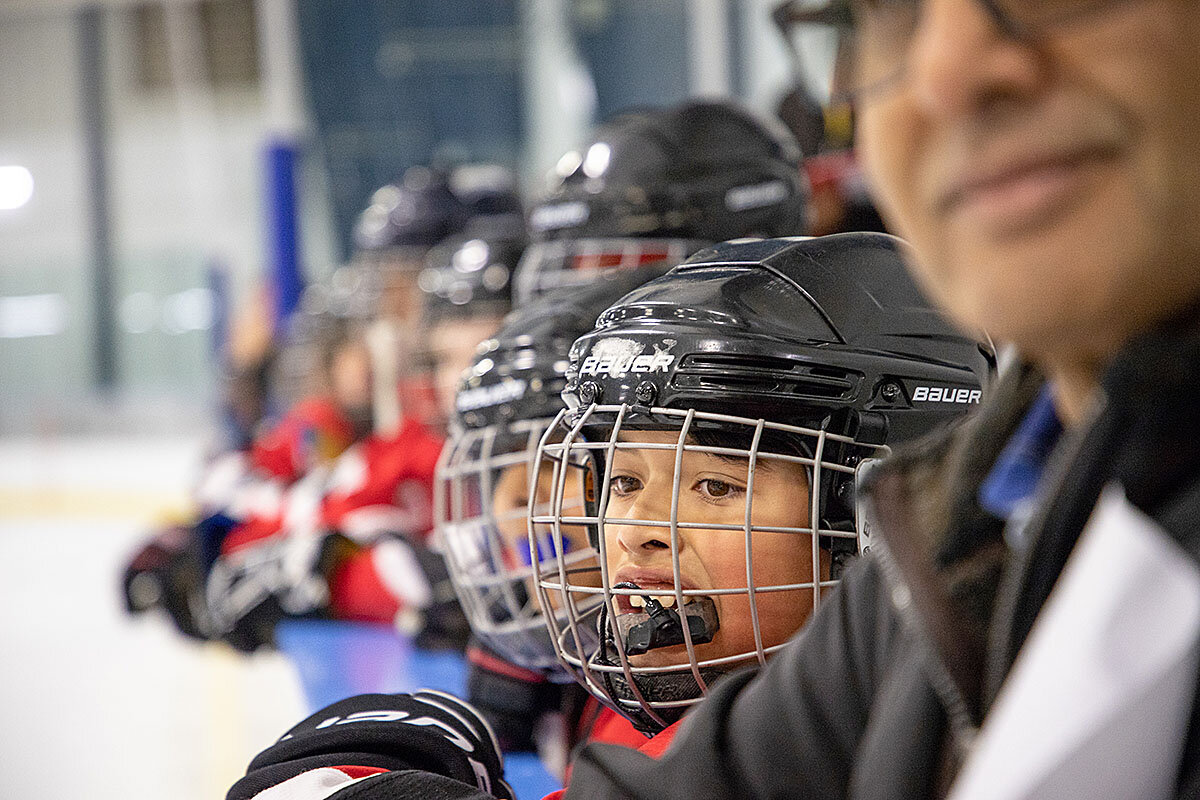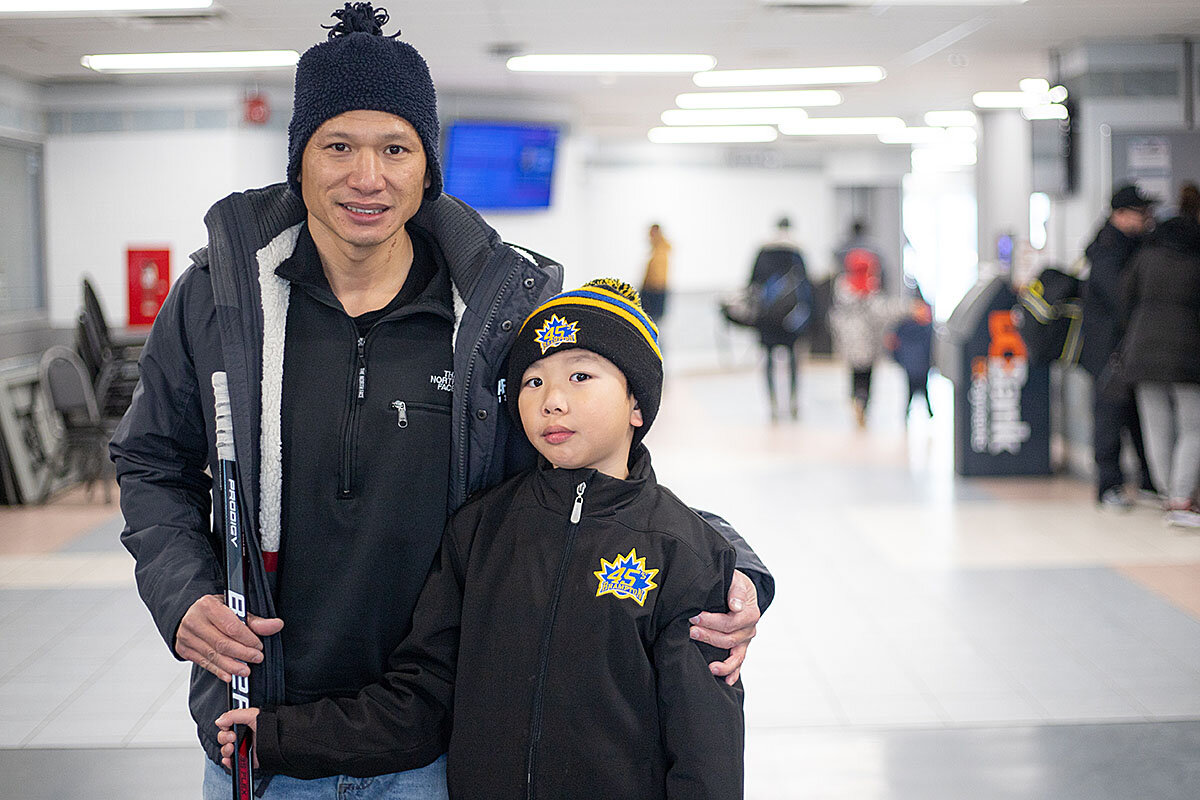‘Not really a white boys’ sport’: Canadian youth hockey gets inclusive
Loading...
| Brampton, Ontario
As a boy, Sinh Nguyen wanted to play hockey like his friends did. But his parents were immigrants to Canada, and looking back, he says they had neither the money nor the know-how to make that happen.
Today he’s an assistant on his son’s team in youth “rep” hockey in Brampton. And as minority team members in this city 30 miles northwest of Toronto which is 73.3% “visible minority” – how Canada describes nonwhite, non-indigenous racial minorities – they fit right in at South Fletcher’s Sportsplex on a recent Saturday morning, as Southeast Asian, South Asian, and black Canadians lace up.
“I think it just depends on where you live, but here I see all the different groups playing the sport,” he says. “It’s not really the old white boys’ sport.”
Why We Wrote This
When a sport is trying to expand beyond its traditional demographics to reach new audiences, perhaps the best place to gauge its progress is at the youth level.
But that’s become a raging debate in Canada in the past month. From the firing of firebrand broadcaster Don Cherry over divisive comments about “you people”; to followup commentary by a television talk show host that hockey in her view is a rich, white sport; to the resignation of Calgary Flames coach Bill Peters last week over racial slurs directed at former NHL player Akim Aliu, hockey is having what’s been called by some Canadian opinion makers its #MeToo movement on race and power.
Yet at the youth level, many teams are already breaking paradigms – and realizing that if they don’t, they face a bleak future.
“Hockey has to connect with Canadians”
The diversity at the rink in Brampton is not just a reflection of the town’s changing demographics. It’s also a concentrated effort by a league that saw its enrollment drop in half – from more than 4,000 to just under 2,000 players, says Brampton Hockey general manager Glenn McIntyre – in the past 25 years. Overall, Hockey Canada registration has fallen to 453,361 participants, down from 500,120 a decade ago.
So the Brampton league has partnered with organizations to go into schools to teach ball hockey or to get newcomers into “learn-to-skate” programs. They have also participated in “First Shift,” a low-commitment entry into hockey, through which about 450 have participated in the past six years.
“Hockey is a Canadian tradition,” says Mr. McIntyre. “And we would like to see it stay that way.”
Last month, the Greater Toronto Hockey League hosted a summit called “The Transition Game” to shift culture and make hockey more inclusive. Although the league’s overall numbers have remained stable, says Scott Oakman, the executive director of the GTHL, registration has not increased alongside population growth.
“One of the comments made at the summit was that a hockey arena should look like a classroom in that community,” says Mr. Oakman. “And I think in parts of Ontario, that’s the case. I think we’ve in our jurisdiction made some inroads into certain communities, but I don’t think we’re anywhere close to having the hockey rink in our jurisdiction reflect what the classroom looks like.”
Part of youth hockey’s problem is the availability of other sports like basketball, especially after the Toronto Raptors’ NBA championship last season. This has happened as hockey has become overly structured, argues Sean Fitz-Gerald, a writer for The Athletic Canada, a hockey dad, and author of “Before the Lights Go Out.”
Professionalized coaches and pressures at the youngest ages trickle down, driving up commitment – and prices. Even if music lessons or competitive swimming can be just as expensive, hockey’s intense schedules can mean “soft costs” (like needing a car or traveling to Buffalo for a tournament) put the sport out of reach. It’s no longer the “everyman sport” for all Canadians, Mr. Fitz-Gerald says.
He says hockey is also not doing a good job of connecting with new Canadians. “Part of that was that for years, hockey’s marketing plan was, ‘Hey, Canada, it’s cold, it’s time to come into the arena. The doors are open,’” he says. “But hockey has to learn, it has to connect with Canadians.”
Opening up to newcomers
There are many attempts to forge those bridges underway. Hockey 4 Youth was started by Moezine Hasham in Toronto in 2015. The organization’s goal is to help speed the path to integration of newcomer teens arriving from Pakistan, or Syria, or Vietnam, via hockey. They started with 30 kids. This year they will be running eight programs with about 250 participants.
Their co-ed program works with schools that are in walking distance of arenas and where students can store their gear – some simple solutions that break down common barriers.
Other minor shifts include intentionally using less insider terminology, says Dwight Graham, vice president of hockey development of Brampton Hockey. He uses language like “pick-up hockey” instead of “shinny” so that new families can be part of the conversation. “When you do that, then they feel more empowered. And when they feel more comfortable, then the inclusion starts,” he says.
Part of the mental shift has to occur within new players, Mr. Hasham says. “I tell my kids all the time, once they’ve started to play hockey and once they feel comfortable on the ice, they’re now hockey players.”
There is also new thinking that has to take place at the league level if programs for newcomers are to scale up. One of the GTHL summit takeaways, says Mr. Oakman, is that hockey has to return to communities. In the Toronto area, he says, that means offering programs at rinks standing idle. “Some would argue, well, there’s no kids playing hockey in that community, that’s why there’s no program there,” he says. “And I would argue, there’s no kids playing hockey in the community, because there’s no program there.”
Andrew Holman, a Canadian history professor at Bridgewater State University in Massachusetts and co-author of “Hockey: A Global History,” says questions about diversity join a history of crises in hockey, from Russian dominance to gender inclusion.
But hockey has also made strides to open up: In Canada, there is “Hockey Night in Canada: Punjabi Edition,” for example, or occasional broadcasts in indigenous languages. And it’s not the only sport that struggles with diversity. But hockey is held to a different standard here. “If you hold out a particular sport to be the emblem of the nation,” he says, “then it better be reflective of the nature of Canadian society.”
Those involved in Brampton’s local league agree. Mr. Graham says about 30% to 40% of Brampton travel program teams are visible minority. “There’s going to be a lag,” adds Mr. Nguyen, just like in his own family.
Mr. McIntyre says he believes that diversity will one day be reflected at the very top, in the NHL. “I honestly think you’re going to see that,” he says, “sooner than later for sure.”








